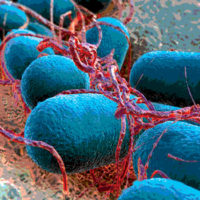Walking on Eggshells: Do You Know the Risks?

Tap. Tap. Crack.
It’s the early morning sound that, together with the coffee pot’s gurgling, makes us immediately hungry. The egg is the ultimate American food staple. Along with bread, milk, and water, it’s one of the first foods to sell out in grocery stores during an extreme weather warning. And there is no question about it: With an impressive range of vitamins, minerals, proteins, and good fats, eggs are nature’s perfect food.
Despite Americans’ familiarity with eggs, many do not know their secret: Eggs are one of the most dangerous foods that we eat. So dangerous that in the last few years alone, hundreds of millions of eggs have had to be recalled. Why all the fuss? Because all too often, those innocent-looking eggs that we buy in the store are contaminated with Salmonella.
And Salmonella is not just trapped inside the eggs. Salmonella can also be on the egg’s shell. When you buy eggs at the grocery store, do you open the carton to make sure they aren’t cracked? Most people do. Do you ever touch the eggs? Millions of Americans do each day. Few Americans realize that those innocent-looking eggshells they have just touched may be contaminated with Salmonella.
It All Starts with the Hen
It’s dawn. A hen is sleeping in her community coop. Shafts of light from the rising sun peek through the holes of her coop, and she begins to stir. The hen lays an egg.
Thus begins the egg’s epic journey to your plate.
It does not stay in the nest for long. As the hen moves about her nest and begins to peck at the feed brought to her on the conveyor belt, the egg slowly rolls down to its own conveyor belt. Along with the other eggs that have been laid that day, the egg gradually makes its way to a processing room.
The egg rolls from one belt to another as it continues through a series of sizing equipment. Next is another conveyor that takes it through a cleaning machine. The egg then is dumped into a water bath to continue the drying and candling process. Next, it is rolled back onto yet another conveyor belt to its next destination. As the egg begins to dry, a processing worker inspects the egg and its compadres, carefully removing any eggs that appear to be broken, malformed, or dirty, essentially any that have not already been removed during the candling process.
As the egg continues on its journey, it passes inspection and moves to the next part of the process: stamping and packaging. A special machine gently suctions the egg and others of its size into an appropriately sized egg carton. It is wrapped and placed in cold storage. From here, the egg could travel to any number of places. It may be distributed to the nearest grocery store. It may be loaded onto a truck and driven to another state. Or it may be exported to another country. Most likely, it will change hands at least three or four more times before arriving at its final destination, the breakfast plate.
But what does the egg’s journey have to do with Salmonella?
Many Americans don’t realize that from before the egg is even laid until the moment when the egg is packaged into its carton, there are repeated opportunities for the egg to become contaminated with Salmonella. And not just on the inside of the egg but on the shell, too.
Herein lies the problem. Egg safety begins with the chicken, or rather, the chicken farmer. In well-run egg farms, farmers are ever vigilant in identifying and then eliminating any possible routes of Salmonella contamination at each step in the egg’s journey from hen to fork. But in poorly run egg farms, eggs may become contaminated during their journey. And if hens become infected with Salmonella, their eggs may be contaminated with Salmonella even before they are laid.
How Salmonella Can Get into (and onto) Eggs
There is nothing new in the link between Salmonella and eggs. When we were children and our mothers told us not to eat raw cookie dough, they were trying to protect us from the danger of Salmonella hidden inside eggs.
But what is the real danger? How can something as small as an egg send someone to the hospital, let alone cause a multi-state outbreak?
There are four main ways that eggs become contaminated:
1. Biosecurity failures that introduce Salmonella into chicken coops
2. Pest infestations
3. Lack of proper cleaning and sanitization procedures
4. Improper holding temperatures
Let’s take a look at each of these factors individually.
Biosecurity Failures
Infected chickens may not show any signs of Salmonella infection. In fact, they rarely do because certain species of Salmonella do not make chickens sick. That is why it is important for egg producers to routinely test their chickens—especially because Salmonella infections in the ovaries can transfer into the egg.
Chickens are messy. They are animals, after all. Unlike us humans (and the more pampered house cats we know), chickens really do not care too much about cleanliness, especially where they walk, eat, or do the other things that nature intends them to do. This means that chickens will pick up any pathogens they encounter in their environment. If an animal, for instance, gets into a coop and exposes the coop to bacteria, the entire coop may become infected. If an infected chicken is introduced to the coop, the infection can spread. This is why it is so important to keep coops clean and free of any potential contaminants.
Pest Infestations
Rodents and flies are not just annoying, but like the spread of plague by fleas on rats, they also cause a huge problem when it comes to pathogens. Again, an entire coop of chickens can become infected through just a cluster of flies. Pests also can leave their own natural elements behind, creating another opportunity for more bacteria to colonize.
Improper Cleaning and Sanitization
The egg’s journey from hen to fork is littered with opportunities for bacterial contamination. As with any food processing facility, proper cleaning and sanitation are crucial. All the more reason why it is not surprising when Salmonella outbreak investigations unearth basic breakdowns in cleaning and sanitation programs. In this year’s Rose Acre Farm outbreak, U.S. Food and Drug Administration (FDA) inspectors observed that the facility’s cleaning procedures were “not being implemented by management and followed by sanitation employees,” that maintenance and sanitation employees were placing food contact equipment “onto floor, pallets, and equipment that was visibly dirty with accumulated grime and food debris, before placing the equipment into service,” and that “production and maintenance employees were observed touching non-food contact surfaces (i.e., face, hair, intergluteal cleft, production equipment with accumulated grime and food debris, floor, boxes, trash cans, inedible transport cans) and then touch[ing] shell eggs and food contact surfaces…”[1]
Improper Holding Temperatures
Say it with us now: “Keep hot foods hot and cold foods cold.” You know the mantra. For those of us in the food safety field, it is ingrained in our brains. We are pretty sure most of us say it over and over during dinner parties when we have that one friend who just has to push the limits of the 2-hour rule.
But when it comes to eggs, proper holding temperatures are more than just a spoilage concern. Holding temperatures are an exposure concern, too. We all assume that eggs are pretty well protected, that their shell is their armor. People often assume that the egg inside will always be OK, despite any environmental exposures the shell may endure.
Dead wrong. The egg’s shell is porous. Bring yourself back to your ninth-grade biology class for a moment. Do you remember learning about cell structure and a little thing called osmosis? Well, eggs do that. When a cold egg is left out at room temperature, the water inside the egg will cause the egg to sweat—or rather transfer to the outside of the egg. This means that whatever pathogens may be lurking on the outside of the egg can do the reverse and pass through the shell into the inside of the egg. And what do we all know about pathogens? They like to grow and colonize. Something as minor as leaving an egg out at room temperature can lead to creating one’s own food poisoning bomb.
Salmonella Outbreaks
Time and again, Salmonella outbreak investigations reveal basic breakdowns in biosecurity, pest control, cleaning and sanitation, and holding temperatures. When it comes to Salmonella egg outbreaks, there really is nothing new under the sun.
These failures are why we repeatedly see outbreaks linked to eggs. The link between Salmonella and eggs is not new. We knew about it back in 1987,[2] when 500 people became sick from eating raw eggs that had become contaminated by Salmonella transmission from the chicken’s ovary to the egg. We saw these same types of food safety violations during the Wright County Egg/DeCoster Farms outbreak in 2010—where FDA inspectors arrived to discover chicken coops teeming with flies, maggots, scurrying rodents, and overflowing manure pits. Wild birds were allowed free run of the coops, infecting laying chickens. Chickens that were obviously sick were allowed to mingle with healthy birds. And that is just a little about the laundry list of food safety violations in that outbreak. Investigations later revealed that these critical food safety violations went back decades.
But that was 8 years ago; surely the egg industry has learned from its mistakes. Surely after the DeCoster catastrophe, egg producers are always doing the right thing. Some are. But others still are not.
We don’t have to look any further than the 2016 Good Earth Egg outbreak and this year’s Rose Acre Farms outbreak to see that there is still a problem. Good Earth Egg failed to test their hens for Salmonella. Their biosecurity measures, or rather lack thereof, failed. Equipment was moved from the coops to the processing areas without first sanitizing it. Cleaning and disinfection systems failed. And don’t even get us started on the rodent infestation.
As for Rose Acre Farms, this latest tale of egg woe is like comparing Romeo and Juliet to Pyramus and Thisbe. Same story, different names. FDA’s investigation revealed pest infestations: “unacceptable rodent activity within a poultry house” and “flying insects throughout the egg processing facility…landing on food, food contact surfaces, and food production equipment”; biosecurity failures: “condensation dripping from the ceiling, pipes, and down walls, onto production equipment” (remember Peanut Corporation of American’s leaking ceiling?); and improper cleaning and sanitation: “insanitary conditions and poor employee practices observed in the egg processing facility that create an environment that allows for the harborage, proliferation, and spread of filth and pathogens throughout the facility…”[1] This year’s Salmonella egg outbreak (and ensuing recall of 207 million eggs) is just the latest of its kind. It’s a tale as old as time.
We are seeing the same violations lead to Salmonella outbreaks over and over. It makes you wonder: Do over a billion eggs need to be recalled and thousands more people become sick before the egg industry wakes up and follows the rules?
A Cage-Free Future
As the egg-producing industry moves toward a cage-free future, many consumers, regulators, producers, and even food safety advocates like us are wondering what this change will mean for food safety and Salmonella.
We are seeing some mixed emotions.
At one end of the spectrum, some egg producers have claimed that going cage-free will open up their chicken flocks to a new laundry list of environmental exposures and potentially lead to a greater risk of illness. But that assumes that cage-free means getting to go outside like free-range chickens. It doesn’t. In most cases, cage-free means just that. No cages. The birds are still cooped up in an indoor coop. They are still packed together. It is like having a seat at your favorite concert hall versus the same concert hall being standing room only. When it rains, there’s still a roof over your head.
Those in favor of the shift cite research showing cage-free production practices improve food safety, specifically studies like the 2009 Huneau-Salaün study[3] (which concluded that the prevalence of Salmonella was found to be higher in caged flocks) and the 2015 Penn State meta-analysis[4] (which concluded cage housing for chickens increases the risk of Salmonella contamination). A 2010 British paper went on to essentially say the same thing—that eggs from caged hens had 7.7 times greater odds of harboring Salmonella bacteria than eggs from noncaged hens.[5]
There are others in the debate who do not necessarily care either way, because they believe that a cage-free shift will not do anything to benefit food safety but will rather appease the customer with a (perhaps misleading) sense that their eggs are now more humanely produced.
Will going cage-free allow for a more sterile environment? Or will it just make things dirtier? Will environmental conditions for laying hens actually be better? Will going cage-free mean more or fewer antibiotics? Or will it have no effect whatsoever? We will just have to see.
The critical question for egg-producing corporations will be: How strong is their food safety culture? Are corporations willing to pay for necessary testing? Are they willing to invest in quality equipment and training of their employees on food safety practices? With a huge investment in new equipment and facilities to allow for cage-free hens, coupled with a concern that the consumer market won’t pay the high premium prices for eggs, will more corners be cut? Will sanitization and cleaning practices be adhered to? These are the pressing questions, whether or not a cage-free shift is in the future of the egg industry.
Food Safety Culture
Ultimately, it all boils down to the egg producer’s food safety culture. You can have the best, most expensive processing equipment the industry has to offer and allow your free-range chickens to frolic in fields of beautiful St. Augustine grass. None of that will be enough to keep the consumer safe from foodborne illness if you have a poor food safety culture. Does your egg processing facility have sound biosecurity controls, pest controls, proper cleaning and sanitizing, and proper temperature holds? Without these, nothing else matters. In the end, there really is no mystery. The industry has had the tools to make our eggs safe all along.
Jory D. Lange Jr., Esq., is a national food safety lawyer in the Lange Law Firm, PLLC, who helps families who have been harmed in food poisoning outbreaks.
Candess Zona-Mendola is a food safety advocate and the senior trial paralegal of the Lange Law Firm, PLLC. She works closely with Jory to advance the firm’s food safety cases and is the editor of MakeFoodSafe.com, a food safety website.
References
1. www.fda.gov/ucm/groups/fdagov-public/@fdagov-afda-orgs/documents/document/ucm604794.pdf.
2. Telzak, EE, et al. 1990. “A Nosocomial Outbreak of Salmonella enteritidis Infection due to the Consumption of Raw Eggs.” N Engl J Med 323:394–397.
3. Huneau-Salaün, A, et al. 2009. “Risk Factors for Salmonella enterica subsp. enterica Contamination in 519 French Laying Hen Flocks at the End of the Laying Period.” Prev Vet Med 89(1-2):51–8.
4. Denagamage, T, et al. 2015. “Risk Factors Associated with Salmonella in Laying Hen Farms: Systematic Review of Observational Studies.” Avian Dis 59(2):291–302.
5. Snow, LC, et al. 2010. “Investigation of Risk Factors for Salmonella on Commercial Egg-Laying Farms in Great Britain, 2004–2005.” Vet Rec 166:579–586.
Looking for a reprint of this article?
From high-res PDFs to custom plaques, order your copy today!









